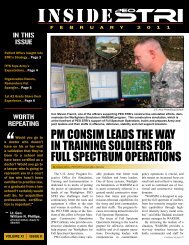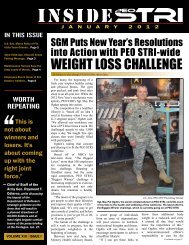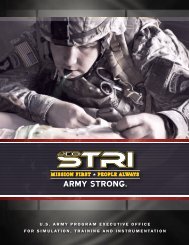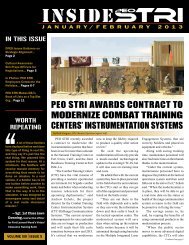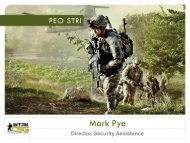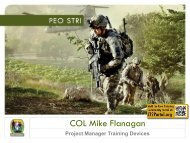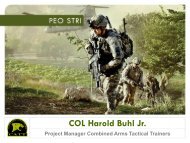inside - PEO STRI - U.S. Army
inside - PEO STRI - U.S. Army
inside - PEO STRI - U.S. Army
Create successful ePaper yourself
Turn your PDF publications into a flip-book with our unique Google optimized e-Paper software.
In this<br />
Issue<br />
<strong>STRI</strong> Employee Stands-Out<br />
at Leadership Program... Page 3<br />
<strong>inside</strong><br />
s e p t e m b e r 2 0 0 8<br />
Ribbon-Cutting Ceremony Marks<br />
New Gaming Lab... Page 4<br />
Acquisition Academy Set to<br />
Graduate First Class... Pages 6-7<br />
Get to Know the New EOQ:<br />
Guy Richards, PM CATT... Page 12<br />
Worth<br />
Repeating<br />
One of the worst<br />
days in America’s history<br />
saw some of the bravest<br />
acts in Americans’ history.<br />
We’ll always honor the<br />
heroes of 9/11. And here<br />
at this hallowed place, we<br />
pledge that we will never<br />
forget their sacrifice.”<br />
President George W. Bush,<br />
speaking at the dedication of the<br />
Pentagon Memorial Sept. 11, 2008<br />
VOLUME VIII<br />
ISSUE VI<br />
<strong>STRI</strong> Contract Trains Deploying<br />
Route Clearance Companies<br />
By Kristen A. Dooley, <strong>PEO</strong> <strong>STRI</strong> Public Affairs Officer<br />
U.S. <strong>Army</strong> Photo/Doug Schaub<br />
U.S. <strong>Army</strong> <strong>PEO</strong> <strong>STRI</strong> awarded the Route Clearance Training Services contract to Raydon Corp., for<br />
the production, fielding and sustainment of the Virtual Route Clearance Trainer. The first phase of<br />
the contact was awarded November 2007 and the second phase was awarded August 2008.<br />
Soldiers from the 36th Engineer Brigade,<br />
937th Route Clearance Company were the<br />
first unit to prepare for their deployment<br />
to Iraq using the Virtual Route Clearance<br />
Trainer. The training that was completed<br />
February 2008 at Fort Hood, Texas, instructed<br />
213 Soldiers how to operate route clearance<br />
vehicles and locate, mark, interrogate and sweep<br />
for improvised explosive devices and land<br />
mines hidden by insurgents.<br />
These Soldiers, who are now deployed,<br />
completed a 40-hour training program that<br />
included mission rehearsal exercises in a<br />
virtual terrain environment that mirrors the<br />
Iraqi cities they are currently operating in. In<br />
addition to the training they received in the<br />
virtual vehicle simulator, the Soldiers underwent<br />
rigorous classroom-based instruction to learn<br />
the latest route clearance tactics, techniques<br />
and procedures.<br />
Together, the coursework and hands-on<br />
instruction were provided to these Warfighters,<br />
and others at Fort McCoy, Wis., and Camp<br />
Shelby, Miss., through the Route Clearance<br />
Training Services contract that <strong>PEO</strong> <strong>STRI</strong>’s<br />
Product Manager for Ground Combat Tactical<br />
Trainers awarded to Raydon Corporation late<br />
2007.<br />
“The Route Clearance Training Services<br />
contract allows engineers preparing to deploy<br />
in support of Operation Iraqi Freedom<br />
the opportunity to train on route clearance<br />
equipment at the homestation prior to<br />
deploying,” said Jim Crabtree, the program’s<br />
project director. “Prior to this contract, all the<br />
engineer units sent Soldiers to Fort Leonard<br />
Wood’s Counter Explosive Hazards Center<br />
for training. Once Soldiers returned to their<br />
units, there was no method to maintain their<br />
proficiency until now.”<br />
Continued on page 9
OPERATIONS SECURITY (OPSEC)<br />
2<br />
Inside <strong>STRI</strong> SEPTEMBER 2008
ELDP: Giving DoD Employees<br />
Invaluable Insight into A<br />
Warfighter’s rOLE AND Mission<br />
By Kellyn D. Ritter, U.S. <strong>Army</strong> Acquisition Support Center Contractor<br />
The Department of Defense’s Executive Leadership<br />
Development Program (ELDP) is a unique opportunity<br />
for DoD employees to gain insight, training and<br />
exposure to the missions and lives of our Warfighters.<br />
Program participants are part of a 10-month program<br />
to train with Warfighters in various locations in the<br />
U.S. and abroad.<br />
ELDP Benefits<br />
Immersion in real-life training and field experiences<br />
gives participants an unparalleled<br />
view into the complex roles of a Warfighter.<br />
Interaction with military and civilian coworkers,<br />
senior leaders and Warfighters gives<br />
participants a more thorough understanding of<br />
the DoD entity and its mission.<br />
Participant Linda M. Comfort, Program<br />
Executive Office Simulation, Training, and<br />
Instrumentation, Orlando, Fla., explained the<br />
benefits of the program: “We captured a snapshot<br />
of what our fine young men and women<br />
in uniform do on a daily basis in support of<br />
our great Nation. We realized the importance<br />
of our decisions made on a daily basis and the<br />
impact they had on our Soldiers, Sailors, Airmen,<br />
and Marines.”<br />
Participants train with each military service,<br />
as well as combined and allied forces around<br />
the world. According to participant Keith M.<br />
Luhmann, U.S. <strong>Army</strong> Research, Development,<br />
and Engineering Command, Picatinny, N.J.,<br />
participating in the program also provides a<br />
new outlook on the term, “joint.”<br />
“It gave me great insight into the joint perspective<br />
and helped me to look beyond my<br />
duties to the overall goals of the DoD, specifically<br />
supporting the Warfighter,” he said. “I<br />
was able to experience so many capabilities of<br />
the different DoD services and agencies that I<br />
didn’t even know existed.”<br />
ELDP was established as a Secretary of Defense<br />
Initiative in 1985 and reflects the Congressional<br />
intent of the Goldwater-Nichols<br />
DoD Reorganization Act of 1986.<br />
DoD has recognized<br />
ELDP’s<br />
importance and<br />
the beneficial results<br />
of instructing<br />
future senior<br />
leaders through<br />
hands-on training<br />
and firsthand experiences.<br />
Gordon England, deputy secretary<br />
of defense, has called ELDP the, “premier<br />
leadership and development program in the<br />
[defense] department.”<br />
Currently, the Office of the Under Secretary<br />
of Defense for Personnel and Readiness is in<br />
charge of the program, with support from the<br />
Office of the Joint Chiefs of Staff, J-7, Military<br />
Education Division, and assistance from<br />
consultants and selected DoD component<br />
personnel.<br />
ELDP is a challenging program both physically<br />
and mentally. Program participants are<br />
carefully chosen and only a few DoD members<br />
are selected to participate. Partaking in<br />
such an exclusive program is one reason why<br />
it is an honor for participants, however being<br />
admitted into the program requires sacrifices.<br />
In the words of participant Scott M. Greene,<br />
U.S. <strong>Army</strong> Acquisition Support Center, Fort<br />
Belvoir, Va., the program “tests your cognitive<br />
ability, physical strength and moral courage.<br />
All the while, you still have your regular<br />
job to complete as well.”<br />
DoD benefits from ELDP because the program<br />
members could very well be future DoD<br />
senior leaders. Providing them the experience<br />
Credit: Photo courtesy of ELDP staff<br />
At the USAF Academy, <strong>PEO</strong> <strong>STRI</strong> employee, Linda Comfort, tries on a USAF<br />
parachute worn by cadets during their daily flights.<br />
and knowledge of how the Warfighter works<br />
leads to success in their future positions.<br />
Comfort expressed how the program enabled<br />
her to understand the Warfighter’s desired<br />
capabilities. “We were exposed to a<br />
small portion of the many facets within DoD,<br />
igniting our desire to learn more and achieve<br />
more, resulting in the ability to provide enhanced<br />
services to those we support on a daily<br />
basis,” she said.<br />
Luhmann agreed. “We interacted daily with<br />
Soldiers, Sailors, Airmen, and Marines, and<br />
got their perspective on Operations Enduring<br />
and Iraqi Freedom—what is working and what<br />
we in the civilian world need to work on,” he<br />
said.<br />
ELDP Class of 2008<br />
The ELDP Class of 2008 graduated this<br />
summer with 53 participants, including six active<br />
duty military. Acquisition, logistics, and<br />
technology workforce members who completed<br />
the program include Corry B. Cox, <strong>Army</strong><br />
Test and Evaluation Command, Huntsville,<br />
Ala., Comfort, Greene and Luhmann.<br />
The ELDP schedule is intensive,as evidenced<br />
by this year’s class. The class conduct-<br />
Continued on page 4<br />
Inside <strong>STRI</strong> SEPTEMBER 2008 3
New Gaming Lab Opens in <strong>STRI</strong> Annex<br />
By Kristen A. Dooley, <strong>PEO</strong> <strong>STRI</strong> Public Affairs Officer<br />
The new Games for Training Lab, located<br />
in the Room 1057 of the <strong>PEO</strong> <strong>STRI</strong> Annex,<br />
officially opened Sept. 12 with a<br />
ribbon-cutting ceremony hosted by the Product<br />
Manager Air and Command Tactical Trainers<br />
(PM ACTT), a subsidiary of Project Manager<br />
Combined Arms Tactical Trainers (PM CATT).<br />
Within the lab, the Games for Training team<br />
said they hope to accomplish a number of<br />
tasks—evaluate commercial products for possible<br />
government use, establish interoperability,<br />
make use of Web 2.0 and create long-haul capabilities.<br />
Most importantly, however, the lab<br />
space will be used to “field the best game-based<br />
training devices to the Warfighter,” said Leslie<br />
Dubow, project director for <strong>PEO</strong> <strong>STRI</strong>’s gaming<br />
technologies.<br />
To mark the opening of the lab, Dr. Jim Blake,<br />
program executive officer for <strong>PEO</strong> <strong>STRI</strong>, and<br />
Col. Francisco Espaillat, project manager for PM<br />
CATT, cut a large yellow ribbon affixed to the<br />
entrance of the workspace. Blake and Espaillat,<br />
along with other senior <strong>PEO</strong> <strong>STRI</strong> leaders, also<br />
received a guided tour of the lab, and even had<br />
the chance to test out one of the training games.<br />
During the ceremony, the many accomplishments<br />
of the relatively new Games for Training<br />
team was also recognized. It was noted that PM<br />
ACTT was the first defense acquisition organization<br />
to transition a PC-based game, DARWARS<br />
Ambush!, from the research and development<br />
community to the Soldier. Since the June 2006<br />
transition, “PM ACTT has distributed DAR-<br />
WARS Ambush! to more than 400 <strong>Army</strong>, Air<br />
Force, Marines Corps, Navy, Homeland Defense,<br />
F.B.I. and R.O.T.C. locations,” Dubow said.<br />
Additionally, <strong>PEO</strong> <strong>STRI</strong>’s gaming team spearheaded<br />
the first Department of Defense gaming<br />
conference, which was supported by all of the<br />
services and other governmental agencies. Since<br />
the first gaming conference, PM ACTT supported<br />
two subsequent symposiums that drew hundreds<br />
of attendees.<br />
In addition to providing a forum to bring together<br />
the games-for-training community, PM<br />
ACTT’s gaming team assisted the U.S. <strong>Army</strong><br />
Training and Doctrine Command in establishing<br />
the Games for Training program of record<br />
in which the program is now fully funded by<br />
the Department of the <strong>Army</strong> through fiscal year<br />
2015.<br />
“In a little more than two years, the [PM<br />
ACTT Games for Training] team has gone from<br />
a small effort supporting DARWARS Ambush!<br />
with customer funding equaling less than $3 million<br />
to a fully-staffed team with $56 million to<br />
provide deploying Soldiers gaming products that<br />
fill crucial training gaps in [improvised explosive<br />
device], language, cultural and negotiation training,”<br />
Dubow commented. <br />
U.S. <strong>Army</strong> Photo/Doug Schaub<br />
Dr. Jim T. Blake (center), Col. Francisco Espaillat (left), and Lt. Col. Gary<br />
Stephens (right) cut the ribbon Sept. 12 to signify the official opening of<br />
<strong>PEO</strong> <strong>STRI</strong>’s new Games for Training Lab.<br />
U.S. <strong>Army</strong> Photo/Doug Schaub<br />
After the ribbon-cutting ceremony and a tour of the new workspace, <strong>PEO</strong><br />
<strong>STRI</strong> senior leaders try out the new Games for Training Lab housed in the<br />
first floor of the Annex building.<br />
ELDP... Continued from page 3<br />
ed orientation Sept. 5, 2007, began core curriculum<br />
training Oct. 20, 2007 and graduated<br />
from the program June 12, 2008.<br />
Their training included two core curriculum<br />
training weeks in Connecticut, seven training<br />
days with the U.S. Pacific Command,<br />
10 training days with the U.S. Navy, U.S.<br />
Marine Corps, and U.S. Coast Guard in San<br />
Diego, Ca., seven training days with the U.S.<br />
Air Force in Las Vegas, Nev., and Colorado<br />
Springs, Co., and training with two forwarddeployed<br />
units visiting Korea, Belgium, Italy<br />
and Germany. The core curriculum culminated<br />
with a week of <strong>Army</strong> training at Fort Benning,<br />
Ga.<br />
A unique part of the ELDP experience is<br />
participating in an intense learning forum with<br />
fellow DoD coworkers. Luhmann said, “Beyond<br />
the curriculum of the program, I also got<br />
to know 52 other DoD employees, each with<br />
a wealth of experience in their own areas of<br />
responsibility. While every person was very<br />
different, our class was united in our drive to<br />
support our troops and the DoD as a whole.<br />
I would recommend the class to any young<br />
<strong>Army</strong> civilians or Soldiers who want to do<br />
more for the service members, understand<br />
their personal strengths and weaknesses and<br />
lead by example in DoD.”<br />
Article originally printed in <strong>Army</strong> AL&T<br />
Online. <br />
4<br />
Inside <strong>STRI</strong> SEPTEMBER 2008
Let’s Talk Finance: Making an Impact<br />
By John W. Kirch, <strong>PEO</strong> <strong>STRI</strong> Chief Financial Manager<br />
One of the most unpleasant moments<br />
in the Finance Directorate<br />
is getting a call from Headquarters<br />
Department of the <strong>Army</strong> (DA) and<br />
hearing the voice on the other end of the<br />
line say, “We’re pulling back $150 million<br />
across the <strong>Army</strong> for an urgent requirement<br />
and <strong>PEO</strong> <strong>STRI</strong>’s portion is expected to be<br />
$10 million. Please let us know by close<br />
of business tomorrow which programs it<br />
should come from.”<br />
A phone call or e-mail like that drives<br />
F-Dir into scramble mode. Within minutes,<br />
our Integration Office will send out an e-<br />
mail to all the business managers for impact<br />
statements.<br />
Although our suspense is short, F-Dir<br />
attempts to give the project management<br />
shops (PMs) as much time as possible to<br />
put together adequate responses to save<br />
their funding, if at all possible. In doing<br />
so, the directorate is left only with an hour<br />
or two to consolidate all the responses, run<br />
sanity checks on them, and make any necessary<br />
edits to keep a consistent format and<br />
bolster the impact statement.<br />
If we are able to come up with strong and<br />
supportable impact statements, we are often<br />
able to minimize or avoid having to return<br />
funding. This is absolutely a team effort<br />
among our F-Dir staff and all the PMs.<br />
Here are some essential tips for preparing<br />
impact statements that will increase<br />
the likelihood of retaining your program’s<br />
funding:<br />
Getting Started<br />
•◘Identify who is the recipient and when they<br />
need it.<br />
•◘Check previous impact statements.<br />
•◘Do not reinvent the wheel.<br />
•◘Do not contradict a recent position.<br />
Format<br />
•◘In the title, state the issue being addressed.<br />
•◘State the purpose in one sentence.<br />
•◘Give background if needed, but keep it brief.<br />
•◘Be concise. Determine if your impact statement<br />
should be a few bullets or a short paragraph,<br />
but no more than one page. Remember,<br />
less is better.<br />
•◘Do not presume the reader knows the subject<br />
or acronyms.<br />
•◘Write in a direct, assertive tone.<br />
Content<br />
•◘Focus on the target audience.<br />
•◘Only address the specified question.<br />
•◘Make your first sentence the impact. Often<br />
the reader does not have time to read a page<br />
of background. If they immediately see the<br />
impact, they may immediately take it off the<br />
cut list.<br />
•◘Do not over-exaggerate; you may have to<br />
substantiate your claims.<br />
•◘When considering what to say and what not<br />
to, keep in mind the chart below.<br />
The problem with the “Don’t Say” list<br />
above is the “so what?” test. If the <strong>Army</strong><br />
Budget Office (ABO) or DA does not see<br />
an answer given to them, they will assume<br />
there is no significant impact.<br />
Also, they are increasingly looking at<br />
obligation rates and disbursement rates to<br />
help them make decisions. They may interpret<br />
poor rates as either you did not need<br />
the money or you planned poorly and can<br />
probably wait another six months to get it<br />
back if you have waited this long to use it.<br />
Transmitting<br />
•◘Coordinate the impact statement through<br />
your business unit’s proper channels.<br />
•◘Submit the statement on time.<br />
•◘If e-mailing, send it as an attachment that can<br />
be easily saved by the recipient.<br />
•◘Include a very brief cover letter stating what<br />
you are sending and in response to what question.<br />
The recipient may be working multiple<br />
actions on similar subjects, so you want to<br />
provide impacts to the appropriate issue.<br />
Remember the “Don’ts”<br />
•◘Do not use confusing language.<br />
•◘Do not make statements like, “it provides 10<br />
percent less effort.”<br />
•◘Do not say the cut will reduce labor and<br />
travel.<br />
•◘Do not restate the system description.<br />
•◘Do not use this as a venue for whining.<br />
•◘Do not blame or attack someone else.<br />
•◘Do not refer the reader to other documents<br />
assuming they have them at hand.<br />
•◘Do not forget to run spell-check.<br />
Finally, keep the best interest of the <strong>Army</strong><br />
in mind. Follow these tips to preserve your<br />
funds in an honest and ethical way and let<br />
the senior leadership do their job, which is<br />
to weigh all the facts and make decisions<br />
that are best for the <strong>Army</strong>.<br />
The F-Dir staff is not just here to pass<br />
along tasks, but to be used as a resource to<br />
help you protect your funding. <br />
Attributes of Imapct Don’t Say Say<br />
Context<br />
Five systems will not be<br />
deployed.<br />
Five of 10 systems will not<br />
be deployed.<br />
Capability Training will be reduced. Five of 10 training sites will<br />
not have critical training<br />
systems.<br />
Ultimate Impact<br />
Business<br />
The contracting action will be<br />
put on hold.<br />
Funding will not be available<br />
for fielding at the planned rate.<br />
Soldiers’ lives will be at risk<br />
in theater due to insufficient<br />
training as a result of the<br />
possible contract actions put<br />
on hold.<br />
Funding cut will cause loss<br />
of key contractor personnel,<br />
increased unit cost, and<br />
longer time to ramp backup.<br />
Potential of termination<br />
cost may exceed funding<br />
cut.<br />
Inside <strong>STRI</strong> SEPTEMBER 2008 5
Jean Burmester, Dean<br />
Hometown: San Jose, Ca.<br />
Education: B.S., Rollins College, and<br />
M.B.A., Florida Institute of Technology<br />
Work experience: Director, ADL Co-<br />
Lab; senior project director, AVCATT<br />
Adam Baldwin<br />
Hometown: St. Petersburg, Fla.<br />
Education: Business management<br />
Work experience: College graduate<br />
David Barger<br />
Hometown: Marietta, Ohio<br />
Education: B.S. in administration<br />
and M.B.A. in business management,<br />
TUI University<br />
Work experience: U.S. <strong>Army</strong><br />
Lauren Bushika<br />
Hometown: Orlando, Fla.<br />
Education: B.B.A. in marketing,<br />
Stetson University<br />
Work experience: Advertising & sales<br />
EO <strong>STRI</strong>’s newly established Acquisition<br />
Academy is set to graduate its first class Oct. 2.<br />
The Academy’s interns completed coursework<br />
that covered everything from an organizational<br />
overview and project manager-specific briefings to detailed<br />
presentations on the many facets of <strong>Army</strong> contracting.<br />
“I believe A2 provided an opportunity for new federal<br />
employees to become acclimated with civil service, discover<br />
what the <strong>Army</strong> is all about, and gain an understanding of<br />
<strong>PEO</strong> <strong>STRI</strong>’s mission,” said Jean Burmester, dean of the<br />
Acquisition Academy. “The interns learned not only from<br />
the instructors, but also from each other.”<br />
“Their primary focus was to learn the rules, regulations<br />
and the basic skills needed to be a contract specialist,”<br />
Burmester noted.<br />
The bulk of the course material was geared to contractual<br />
issues that <strong>PEO</strong> <strong>STRI</strong> primarily deals with, for example<br />
source selection, service contracts and indefinite delivery,<br />
indefinite quantity contracts.<br />
“The Academy was very well planned out,” said Keith<br />
Thomas, an A2 intern. “The instructors have been great,<br />
and the experience has prepared me to succeed as a<br />
contract specialist at <strong>PEO</strong> <strong>STRI</strong>.<br />
In addition to becoming familiar with government<br />
contracting, the curriculum included topics like <strong>Army</strong><br />
101, getting around <strong>PEO</strong> <strong>STRI</strong>, getting to know the<br />
organization’s products and services, and visiting various<br />
contractors.<br />
“A2 has been a great experience,” said Purvi R. Kapadia,<br />
an intern at the Academy. “Having met with all the project<br />
managers from different shops gave us the opportunity to<br />
see what time of products we will be dealing with in the<br />
organization.<br />
Although the coursework was quite rigorous, the<br />
interns said that it has been a rewarding experience<br />
because they have learned a lot about civil service and<br />
<strong>Army</strong> contracting.<br />
“My time here has been amazing. I cannot imagine<br />
a better place to start my career,” said Adam Bardwin,<br />
an A2 intern. <br />
Marvin J. Hagan<br />
Hometown: Biloxi, Miss.<br />
Education: M.S. in multinational<br />
business operations, Florida State<br />
University<br />
Work experience: Summer hire, U.S.<br />
Air Force<br />
David McGovern<br />
Hometown: Oviedo, Fla.<br />
Education: B.S. in business management,<br />
University of Central Florida<br />
Work experience: Florida Hospital<br />
Emergency Room<br />
Terri L. Harvey<br />
Hometown: Frostproof, Fla.<br />
Education: B.S. in psychology, Bethune-<br />
Cookman University and M.B.A. in health<br />
services administration, Nova Southeastern<br />
University<br />
Work experience: Insurance and car<br />
rental industry; student records coordinator,<br />
Nova Southeastern University<br />
Tony Pham<br />
Hometown: Saigon, Vietnam;<br />
Orlando, Fla.<br />
Education: M.B.A., Webster<br />
University<br />
Work experience: Hotelier<br />
Purvi R. Kapadia<br />
Hometown: Orlando, Fla.<br />
Education: M.B.A., University of<br />
Phoenix<br />
Work experience: Banking industry<br />
Jennifer Salinas<br />
Hometown: Dunnellon, Fla.<br />
Education: B.S. in finance, University<br />
of Florida<br />
Work experience: Program analyst with<br />
Stanley Corp., supporting <strong>PEO</strong> <strong>STRI</strong><br />
6<br />
Inside <strong>STRI</strong> SEPTEMBER 2008
Danielle Cador<br />
Hometown: Anchorage, Ala.<br />
Education: B.S. in marketing and<br />
management and M.S. in international<br />
business, Regis University<br />
Work experience: Ent Federal Credit<br />
Union; Enterprise Rent-A-Car<br />
Virginia Christensen<br />
Hometown: Germany; Oviedo, Fla.<br />
Education: B.S. in technical management,<br />
DeVry University<br />
Work experience: Real estate title<br />
agent<br />
Philip Duncan<br />
Hometown: Not specified<br />
Education: M.S. in industrial engineering,<br />
University of Central Florida<br />
Work experience: U.S. Air Force<br />
MaryJane Gresko<br />
Hometown: Oviedo, Fla.<br />
Education: B.S. in business administration<br />
Work experience: Telecommunications<br />
and publishing<br />
Allison Laera<br />
Hometown: Orlando, Fla.<br />
Education: B.S. in business management,<br />
pursuing an M.B.A, both from<br />
the University of Central Florida<br />
Work experience: A-1 Block Corp.<br />
Jason Malak<br />
Hometown: West Deer Township, Penn.<br />
Education: M.B.A., University of<br />
Central Florida<br />
Work experience: Everything – from<br />
working on cars to procurement<br />
Denise Martin<br />
Hometown: Corunna, Mich.<br />
Education: M.B.A.<br />
Work experience: Communication<br />
security<br />
Scott McCabe<br />
Hometown: Warsaw, N.Y.<br />
Education: B.S. in economics, State<br />
University of New York, Geneseo<br />
Work experience: Accountant,<br />
University of Central Florida<br />
Brian Serra<br />
Hometown: Rockledge, Fla.<br />
Education: B.S. in business administration<br />
and marketing, University of<br />
Central Florida<br />
Work experience: Technical recruiter<br />
Iain Skeete<br />
Hometown: Navarre Beach, Fla.<br />
Education: B.S. in marketing,<br />
University of Central Florida<br />
Work experience: Luxury sales<br />
Anthony Stephenson<br />
Hometown: Orlando, Fla.<br />
Education: B.S. in business management,<br />
University of Phoenix<br />
Work experience: Marketing, Orlando<br />
Regional Medical Center<br />
Keith Thomas<br />
Hometown: Little Rock, Ark.<br />
Education: B.S. in business<br />
management, University of Central<br />
Florida<br />
Work experience: New Client Relations,<br />
Charles Schwab<br />
Inside <strong>STRI</strong> SEPTEMBER 2008 7
The Truth about Wills<br />
By Laura Cushler, <strong>PEO</strong> <strong>STRI</strong> Associate Counsel<br />
As the federal workforce ages and the<br />
baby boomers become retirement<br />
eligible, many of us spend plenty of<br />
our free time thinking about the money we will<br />
have available at retirement. What have you<br />
done, however, to plan out your estate?<br />
The truth is that most of us, some 70 percent<br />
of adult Americans, have neglected to write a<br />
will. Some think their assets are just too puny to<br />
worry about and others worry that the costs of<br />
writing a last will and testament are too high.<br />
Wills are not just vehicles for the wealthy or<br />
the morbid. If you have a family and a home,<br />
not to mention a savings account, you should<br />
definitely have a will.<br />
Cost is no excuse. While the average will<br />
drawn up by a lawyer typically runs from $500<br />
to $1,000, you can get a simple will at a legal<br />
clinic for as little as $75. In addition, if you are<br />
eligible for legal assistance, most military legal<br />
offices can provide you with a will and other<br />
estate planning documents at no cost.<br />
For most people, the first time in your life<br />
that a will becomes imperative is when you<br />
have children.<br />
Forget about your assets for a minute. In<br />
the terrible event that you and your spouse<br />
die at the same time without a will, it falls to a<br />
probate court judge to name a guardian for your<br />
minor-aged children. In a will, however, you<br />
can name a guardian to take care of your minor<br />
children and you can choose someone you<br />
trust. You may also name an alternate guardian<br />
in case your first choice cannot or will not act<br />
as guardian.<br />
Your will can also include a trust for your<br />
minor children where someone that you can<br />
depend on with handling financial matters can<br />
act as trustee over your child’s trust.<br />
Writing a will is also your chance to clarify<br />
who gets what in your estate. Before you can<br />
do that, however, you have to tally up your<br />
assets. Your assets include your house, your<br />
investment portfolio, the value of your Thrift<br />
Savings Plan and I.R.A., your savings, and the<br />
payout on all of your insurance policies. You<br />
may be surprised when you add up all of your<br />
assets because most people are worth more<br />
than they think.<br />
Once you list your assets, you can decide<br />
what you want to leave to whom and who will<br />
be executor of your estate. One important<br />
warning: make sure that the beneficiaries<br />
listed in your will match the beneficiaries you<br />
name on your insurance policies and on your<br />
Thrift Savings Plan and any other retirement<br />
accounts.<br />
Your beneficiary designation overrules<br />
anything else when it comes to your insurance<br />
policies and Thrift Savings Plan, so you may<br />
want to review your designations any time you<br />
have a life-changing event, such as marriage,<br />
divorce or birth of a child.<br />
As part of your estate planning, you also<br />
may want to set up a separate “living trust” to<br />
protect your assets. Such trusts are not cheap<br />
and this is not a service available from a legal<br />
assistance attorney. Living trusts can cost<br />
several thousand dollars. The primary reason<br />
people set up a living trust is to protect their<br />
heirs from having to pay hefty estate taxes<br />
that can turn their carefully built nest egg into<br />
chicken feed.<br />
Remember, for every dollar you leave<br />
behind more than $2 million, the I.R.S. will<br />
take at least 45 cents in estate taxes. The good<br />
news is that the government is increasing this<br />
tax exemption to $3.5 million in 2009. There<br />
is no estate tax, no matter the value, on estates<br />
probated in 2010, but the estate tax exemption<br />
decreases back to $1 million in 2011.<br />
Once you have a will in place, do not forget<br />
to review it and update it as needed. You should<br />
amend your will whenever there is a big change<br />
in your family’s circumstances: a birth, a death,<br />
a marriage, or if you move out of state.<br />
A will may seem like a hassle, but having<br />
one is preferable to the troubles your heirs will<br />
endure if you are unfortunate enough to die<br />
without one. <br />
8<br />
Inside <strong>STRI</strong> SEPTEMBER 2008
TEAM ORLANDO IN PICTURES<br />
U.S. <strong>Army</strong> Photo/Doug Schaub<br />
U.S. <strong>Army</strong> Photo/Doug Schaub<br />
U.S. <strong>Army</strong> Photo/Doug Schaub<br />
U.S. <strong>Army</strong> Photo/Doug Schaub<br />
The Association of the United<br />
States <strong>Army</strong> Sunshine Chapter<br />
tied for the best AUSA chapter<br />
in the southeast region. AUSA<br />
Sunshine Chapter president,<br />
Mary Trier, presented the award<br />
to Dr. Jim Blake, <strong>PEO</strong> <strong>STRI</strong> program<br />
executive officer, July<br />
21 because the trophy will be<br />
housed at <strong>PEO</strong> <strong>STRI</strong>.<br />
The Project Manager Combined<br />
Arms Tactical Trainers celebrated<br />
a Change of Charter ceremony<br />
July 21 when Col. Craig<br />
Langhauser (left) handed over<br />
the reigns to Col. Francisco Espaillat<br />
(right), former product<br />
manager for Force Protection<br />
at the Program Executive Office<br />
Combat Support and Combat<br />
Service Support.<br />
Col. Kevin Dietrick, former deputy<br />
program executive officer<br />
for <strong>PEO</strong> <strong>STRI</strong>, recently retired<br />
from the U.S. <strong>Army</strong>. An Aug. 8<br />
ceremony officiated by Dr. Jim<br />
Blake, program executive officer<br />
for <strong>PEO</strong> <strong>STRI</strong>, was held to mark<br />
his retirement.<br />
The Project Manager Constructive<br />
Simulation celebrated a<br />
Change of Charter ceremony<br />
Sept. 5 as Col. Karen Saunders,<br />
former product manager for Future<br />
Combat System Battle Command,<br />
received the charter from<br />
Col. Ken Wheeler, who assumed<br />
the responsibilities as deputy<br />
program executive officer for<br />
<strong>PEO</strong> <strong>STRI</strong>.<br />
Clearance Companies... continued from cover<br />
The contract was awarded November 2007<br />
in response to an urgent needs statement from<br />
the United States <strong>Army</strong> Engineer School at Fort<br />
Leonard Wood, Mo., to support Soldiers who<br />
operate the Mine Protected Clearance Vehicle<br />
Buffalo, Vehicle Mounted Mine Detector Husky,<br />
and the Medium Mine Protected Vehicle RG-31.<br />
“This was a milestone for training combat<br />
engineer units since it was the first virtual<br />
simulator provided to instruct route clearance<br />
and counter-IED operations,” said Fran Fierko,<br />
deputy project manager for <strong>PEO</strong> <strong>STRI</strong>’s Project<br />
Manager for Combined Arms Tactical Trainers.<br />
“The [contract] provides the capability to conduct<br />
pre-deployment training on route clearance<br />
operations that would not have been possible<br />
otherwise due to the lack of tactical vehicles in<br />
[the U.S.].”<br />
Since the contract award, more than 1,000<br />
Soldiers trained under the Route Clearance<br />
Training Services contract. The majority of<br />
the training has been for newly formed route<br />
clearance companies that need instruction before<br />
they deploy to Iraq or Afghanistan. The first time<br />
the Soldiers operate an actual route clearance<br />
vehicle is in theater.<br />
Although this may seem like quite a leap, “the<br />
Soldiers have said they think it’s the best training<br />
they’ve ever received since they have been in the<br />
<strong>Army</strong>,” Crabtree noted.<br />
A second award of the Route Clearance<br />
Training Services contract was made August<br />
2008. Much like the initial phase of the contract,<br />
brand new route clearance companies who are<br />
preparing to deploy will receive both classroom<br />
instruction and hands-on training. If all the<br />
options are exercised, both phases of the contract<br />
could total more than $67 million.<br />
For the second phase, however, the Virtual<br />
Route Clearance Trainer will be amplified with<br />
four Buffalos, four RG-31s, two Huskys, a Joint<br />
Explosive Ordnance Disposal Rapid Response<br />
Vehicle, an explosive ordinance disposal robot,<br />
and five instructor-operator and after action<br />
review stations. This is quite a step up from<br />
the first phase that fielded four Buffalos (one<br />
of which could convert to a Husky) and two<br />
RG-31s.<br />
Additionally, the follow-on phase will include<br />
fieldings to Forts Leonard Wood, Carson, Riley,<br />
Bragg, Drum, Hood, Lewis and White Sands<br />
Missile Range—more than double the locations<br />
than it was fielded the first time around.<br />
“The Route Clearance Training Services<br />
contract will ensure the maneuver commander<br />
receives trained and combat ready engineers<br />
that can provide the mobility expected on the<br />
battlefield,” Crabtree said. <br />
Inside <strong>STRI</strong> SEPTEMBER 2008 9
<strong>PEO</strong> stri: Embracing the<br />
New World of Security<br />
By Bill Osborne and Donnette Hart, <strong>PEO</strong> <strong>STRI</strong> Security Office<br />
Some of us have been around long<br />
enough to remember when offices<br />
relied on typewriters, carbon paper and<br />
the mail as a regular means of conducting<br />
business. Times have changed and the security<br />
community is keeping up with these changes<br />
by automating many of the functions related to<br />
security clearances.<br />
Just a few years ago, a certificate for a newly<br />
granted security clearance was sent from<br />
the U.S. <strong>Army</strong>’s Central Clearance Facility<br />
(CCF) to an individual’s security office. The<br />
certificate was kept on file and used as the<br />
source document to prove a person’s eligibility<br />
for access to classified information.<br />
Today, the practice of using a “Security<br />
Clearance Certificate” is obsolete. The CCF<br />
has not issued a clearance certificate in more<br />
than three years. The Department of Defense<br />
now uses an automated record system called<br />
the Joint Personnel Adjudicative System, or<br />
JPAS.<br />
JPAS gives security managers real-time<br />
access to security clearance records for anyone<br />
in the DoD who has, or recently had, a security<br />
clearance. This greatly improves the way<br />
security offices conduct business.<br />
Since the CCF no longer mails clearance<br />
certificates, electronic notifications are sent<br />
through JPAS to each person’s security office<br />
whenever a clearance is granted or record is<br />
updated.<br />
Another improvement brought about with<br />
the JPAS system is the ability to submit Visit<br />
Request forms electronically. The old method<br />
involved preparing Visit Request forms online,<br />
submitting them to the security office for<br />
verification and then faxing the form to the site<br />
to be visited. Because the forms contained a<br />
significant amount of data, there was always a<br />
chance for errors.<br />
Now, all that is required to send a visit<br />
through JPAS is to send an e-mail to the<br />
security office. The e-mail should identify the<br />
travel destination’s JPAS Security Management<br />
Office code, name and phone number of the<br />
visit point of contact, dates of travel, and<br />
the names of the individuals traveling. The<br />
process is faster, more efficient and more<br />
secure because it is transmitted through the<br />
JPAS system.<br />
The most obvious impact of the JPAS system<br />
has been the increased speed most transactions<br />
occur. For example, the time taken between<br />
investigation closure and clearance award has<br />
been greatly reduced. This has really been<br />
noticeable in the area of Top Secret-Sensitive<br />
Compartmented Information clearances.<br />
Previously, those adjudications took an<br />
average of two years to complete and now take<br />
an average of six months.<br />
Updates to records are immediate because<br />
we never have to wait for certificates to arrive<br />
in the mail. Automation of security clearance<br />
records now enables security personnel to<br />
immediately verify eligibility for access to<br />
classified information. If access is suspended<br />
or revoked, the person’s record is annotated<br />
and they are not inadvertently granted access<br />
to classified information or a secured facility.<br />
Change is sometimes difficult to embrace.<br />
When it comes to automating security<br />
clearance processes, however, the advantages<br />
of these changes far outweigh the negatives.<br />
We can now fondly reminisce upon the good<br />
old days of typewriters, carbon paper, and<br />
clearance certificates. <br />
“Change is sometimes<br />
difficult to embrace.<br />
When it comes to<br />
automating security<br />
clearance processes,<br />
however, the advantages<br />
of these changes far<br />
outweigh the negatives.”<br />
10<br />
Inside <strong>STRI</strong> SEPTEMBER 2008
HOLIDAYS<br />
Events<br />
Sept. 19-22<br />
NGAUS Conference<br />
Sept. 26<br />
Leadership Development Seminar<br />
Oct. 2<br />
Acquisition Academy Graduation<br />
Oct. 3<br />
Oktoberfest<br />
Oct. 6-8<br />
AUSA Conference<br />
Oct. 13<br />
Columbus Day<br />
Tip of the Month<br />
By Marge Hadbavny, Protocol Officer<br />
Business Cards:<br />
The Handshake You Leave Behind<br />
An attractive card, properly presented,<br />
makes a tremendous impression. Here<br />
are five tips to help you present your card<br />
in the most professional manner.<br />
1. Do not force your card on anyone.<br />
Politely ask, “May I give you my card?”<br />
2. Do not give out a business card that is<br />
soiled or out-of-date. Make sure your<br />
card contains correct information.<br />
3. Carry your cards to all business<br />
events. Also, carry a supply when you<br />
attend social events where business<br />
opportunities may develop.<br />
4. Present your card with the print facing<br />
the recipient. The other person should<br />
not have to turn it around to read it.<br />
5. Carry your cards in a nice case to keep<br />
them fresh and protected. It makes a<br />
statement about you.<br />
New business cards were recently created<br />
for the <strong>PEO</strong> <strong>STRI</strong> workforce. The template<br />
can be found on the Graphics and<br />
Presentations SharePoint site. Note that<br />
the <strong>PEO</strong> <strong>STRI</strong> Graphics Department is<br />
not permitted to print business cards and<br />
each employee must purchase and use his<br />
or her own cardstock for the cards. <br />
“One way I’ve been dealing with the slumping economy is by<br />
eating out less. In the past, I enjoyed eating out as many as four<br />
times per week. Now, that isn’t as doable. I eat out maybe once<br />
a week, including breakfast and lunch.”<br />
Michelle Rhyne,<br />
PM CATT<br />
U.S. <strong>Army</strong> Photo/Doug Schaub<br />
“To deal with the slumping economy, my wife and I are reducing<br />
the number of times that we eat out, increasing the energy<br />
efficiency at our home, and combining errands into one big trip<br />
instead of multiple small trips.”<br />
Maj. Timothy McGrew,<br />
PM CATT<br />
U.S. <strong>Army</strong> Photo/Doug Schaub<br />
“I have been staying home more and doing more things for<br />
entertainment that are free: going to the beach, walking to the<br />
community pool and racquetball courts, and watching movies<br />
on the free on-demand. I also let my lawn guy go, and cut my<br />
wireless minutes by 75 percent.”<br />
Caron L. Rigali,<br />
Acquisition Center<br />
U.S. <strong>Army</strong> Photo/Doug Schaub<br />
“How am I dealing with the slumping economy? By watching<br />
the stock market fall and crying at the same time.”<br />
Mark St. Moritz,<br />
Acquisition Center<br />
U.S. <strong>Army</strong> Photo/Doug Schaub<br />
Want your opinion heard? Answer October’s Question!<br />
“Will you vote in the upcoming presidential election? Why or why not?”<br />
Send your response to Kristen.Dooley@us.army.mil and put Citizen <strong>STRI</strong> in the subject line.<br />
Inside <strong>STRI</strong> SEPTEMBER 2008 11
INTRODUCING<br />
Guy Richards<br />
THE<br />
By Kristen Dooley, <strong>PEO</strong> <strong>STRI</strong> Public Affairs Officer<br />
uy Richards, chief engineer for<br />
Product Manager Special Operations<br />
Forces Training Systems (PM STS),<br />
was named <strong>PEO</strong> <strong>STRI</strong>’s Employee of the<br />
Quarter at the Sept. 4 Town Hall Meeting.<br />
“His initiative, acquisition experience and<br />
dedication to the product manager and to his<br />
fellow team members were critical to PM<br />
STS meeting mission goals in support of the<br />
Warfighter,” wrote Lt. Col. Lee Dunlap, PM<br />
STS product manager, in Richards’ Employee<br />
of the Quarter nomination letter.<br />
In May 2008, four of PM STS’ assistant<br />
product managers either retired or transitioned<br />
out of the organization. So that no task or<br />
assignment fell through the cracks, Richards<br />
provided “critical technical and management<br />
oversight, and guidance to engineers and<br />
acquisition logisticians that were assigned as<br />
acting project directors until the new assistant<br />
product managers arrived,” Dunlap said.<br />
Between May 2008 when the former<br />
assistant product managers left and August<br />
2008 when the new ones arrived, Richards<br />
coordinated with all the acting product<br />
managers to ensure that program management<br />
efforts were complete, and engineering<br />
and technical efforts were accomplished.<br />
Additionally, he mentored and provided<br />
guidance to the acting assistant product<br />
managers.<br />
This was no small duty being that PM<br />
STS is responsible for supporting the U.S.<br />
Special Operations Command’s simulation<br />
and training efforts, and the U.S. <strong>Army</strong>’s Call<br />
for Fire Trainer program.<br />
“Mr. Richards performed far beyond what<br />
is expected from a chief engineer, and he<br />
ensured PM STS was able meet its mission<br />
goals and satisfy customer requirements,”<br />
Dunlap wrote.<br />
Richards, a <strong>PEO</strong> <strong>STRI</strong> employee since<br />
January 1995, said he best likes working at<br />
<strong>PEO</strong> <strong>STRI</strong> because of the “challenging and<br />
dynamic programs that directly benefit the<br />
Warfighter.”<br />
As for the future, Richards’ professional<br />
goal is to “continue to support the Warfighter<br />
with an eye on retirement.”<br />
Outside of work, Richards said he enjoys<br />
spending time with his family and traveling. <br />
“His initiative, acquisition<br />
experience and dedication<br />
to the product manager<br />
and to his fellow team<br />
members were critical to<br />
PM STS meeting mission<br />
goals in support of the<br />
Warfighter.”<br />
MAJ Jeffrey Dudley<br />
Hails<br />
Joseph Fratarcangeli<br />
Thomas Kehr<br />
MAJ Thomas Nguyen<br />
Thomas Petrillo<br />
Michelle Rhyne<br />
COL Karen Saunders<br />
James Stauffer<br />
Virginia Crews<br />
COL Kevin Dietrick<br />
Amy Donlin<br />
Joyce Heine<br />
Douglas Hoover<br />
Farewells<br />
COL Craig Langhauser<br />
John Loper<br />
Bobby Macedonia<br />
Judy Taylor<br />
Inside<br />
Inside <strong>STRI</strong> is an authorized publication for<br />
military and civilian members of the U.S. <strong>Army</strong><br />
Program Executive Office for Simulation, Training<br />
and Instrumentation, Orlando, Fla. 32826. Inside<br />
<strong>STRI</strong> is published under the authority of AR 360-1<br />
and applies the Associated Press Stylebook industry<br />
standard.<br />
Contents of Inside <strong>STRI</strong> are not necessarily<br />
the official views of, or endorsed by, the U.S.<br />
Government, Department of Defense, Department<br />
of the <strong>Army</strong>, or <strong>PEO</strong> <strong>STRI</strong>.<br />
Editorial material for publication should be<br />
submitted to <strong>PEO</strong> <strong>STRI</strong> Public Affairs Office, 12350<br />
Research Parkway, Orlando, Fla. 32826. The PAO<br />
reserves the right to edit all material submitted for<br />
publication.<br />
For more information about <strong>PEO</strong> <strong>STRI</strong> or to<br />
view Inside <strong>STRI</strong> online, visit our Web site at www.<br />
peostri.army.mil<br />
Editor:<br />
Kristen Dooley<br />
Editor-in-Chief<br />
kristen.dooley@us.army.mil<br />
Design:<br />
Dwain Fletcher Co.<br />
CGgraphics@us.army.mil<br />
PM CATT<br />
Legal<br />
PSG<br />
PM CATT<br />
CIO<br />
PM CATT<br />
PM ConSim<br />
BOO<br />
PM ITTS<br />
D<strong>PEO</strong><br />
PM ITTS<br />
CSG<br />
PM CATT<br />
PM CATT<br />
Acq. Center<br />
CSG<br />
PSG<br />
12<br />
Inside <strong>STRI</strong> SEPTEMBER 2008



